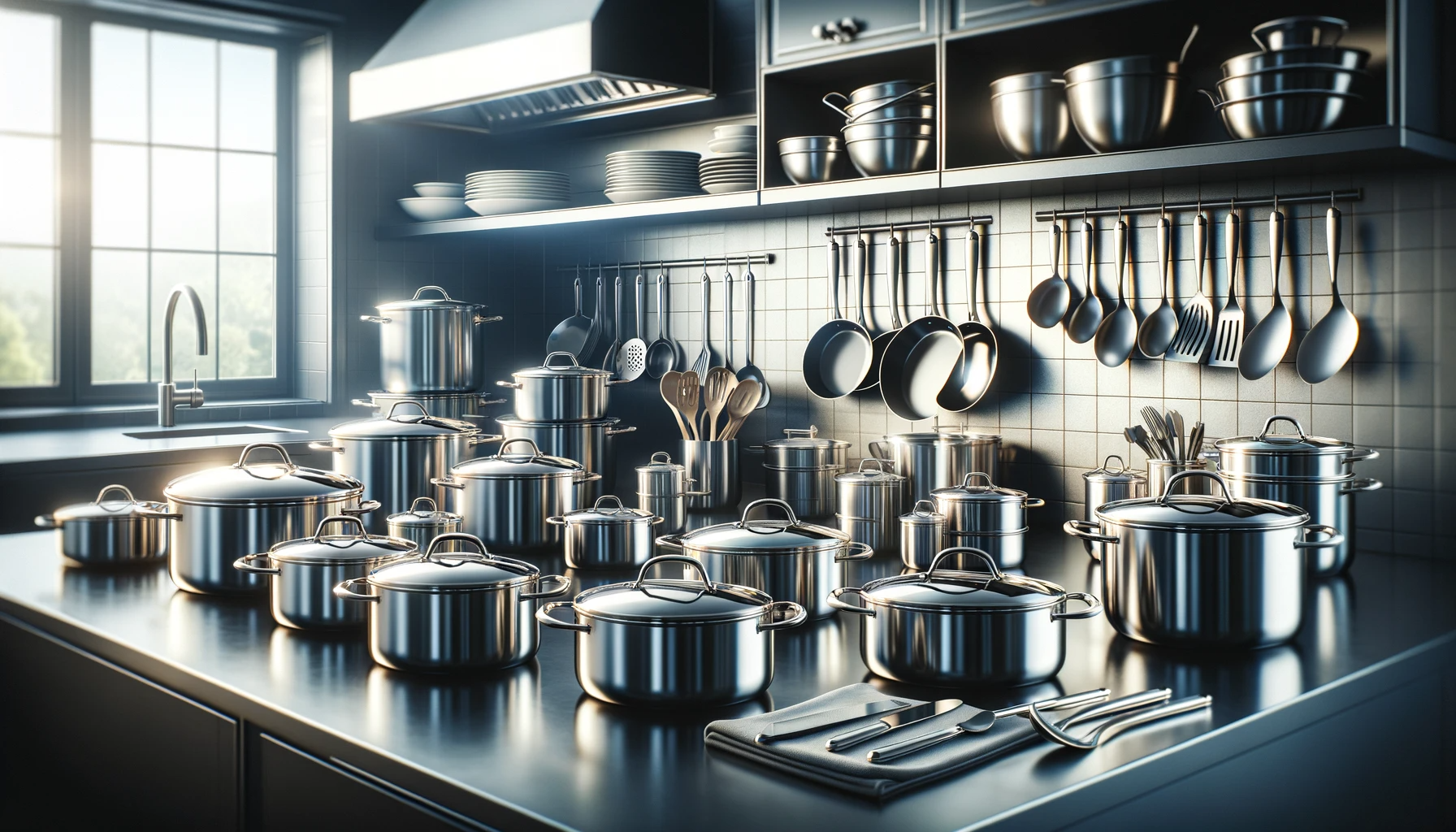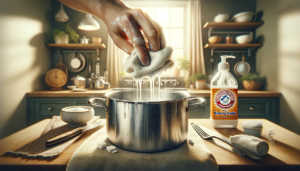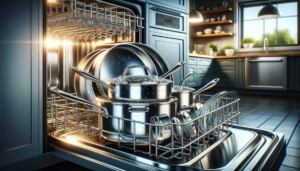Is your shiny new surgical steel cookware set secretly poisoning your family’s meals? Conflicting information about its safety can set your mind spinning!
Surgical stainless steel pots and pans require informed buying decisions and proper care for long-lasting, safe usage as ideal kitchen cookware.
Let’s dive into understanding surgical steel’s properties, benefits and downsides fully to make the right choice for your cookware needs.
Is Surgical Steel Cookware Safe For Cooking?

The straightforward answer is yes – surgical steel pots and pans are overwhelmingly considered safe for daily cooking purposes in home kitchens.
When produced by reputable brands using food-grade stainless steel alloys and properly cared for by owners, surgical steel cookware provides reliably safe, inert and durable performance for meal preparation.
Of course, as we’ll explore in detail below, there are some important purchasing criteria and usage precautions to factor in, especially for those with metal sensitivities.
Generally speaking though, surgical stainless steel is durable, non-reactive and resistant to leaching toxic substances when used correctly.
What is Surgical Stainless Steel?

Surgical stainless steel refers to a grade of stainless steel alloy that contains chromium, nickel and molybdenum.
It was originally created for use in manufacturing medical instruments and equipment that could withstand repeated sterilization.
The main reason why surgical stainless steel has applications beyond the medical field is due to its exceptional corrosion resistance properties.
This makes it very durable and ideal for environments that demand longevity.
Nowadays, you can find surgical stainless steel as a common material used in making cookware products like pots, pans and skillets.
The most commonly used grades of surgical stainless steel preferred for cookware are 304 and 316.
Both contain similar compositions but 316 contains more nickel and molybdenum – additional elements that help improve resistance to rust and corrosion.
This higher grade of steel makes it pricier yet more resistant to damage and deterioration.
As a whole, surgical steel cookware offers a good balance of durability, longevity, ease of maintenance and style.
Benefits of Surgical Steel Cookware

Surgical steel pots and pans have become popular options in many modern kitchens due to the unique benefits this metal offers for cooking performance and convenience, such as:
Extreme Durability and Longevity
Surgical stainless steel is highly durable thanks to its sturdy construction and corrosion-resistant surface.
This allows cookware made from this metal to deliver years of reliable usage while maintaining its original pristine appearance.
The sturdy material prevents dents, warping and damage to the cookware even when subjected to daily wear-and-tear.
Resistant to Corrosion and Rust
The chromium content in stainless steel creates an invisible passive layer of chromium oxide on the cookware surface.
This protective layer acts as a shield against rust and corrosion.
As a result, surgical steel cookware does not degrade over time like some other metals.
You can use such pots and pans for decades without deterioration.
Non-Reactive Surface
The protective layer in surgical steel also prevents the cookware from reacting with acidic foods during cooking.
This means food flavors and tastes do not get altered by the cookware material.
One can cook various cuisines in surgical steel without worrying about metallic tastes in the final dishes.
Oven and Dishwasher Safe
Quality surgical steel cookware can withstand high cooking temperatures just as well as cleaning in the dishwasher.
One does not need to hand wash such pots and pans meticulously.
Just tossing them in the dishwasher occasionally is enough to keep the cookware sparkling clean in between usages.
Easy Maintenance and Cleaning
Thanks to the non-porous and smooth surface, surgical steel cookware does not allow food residues to stick stubbornly after cooking.
Users can clean such pots and pans easily just by using hot water, mild soap and a soft sponge or cloth.
The material is also scratch-resistant, so the cleaning process does not damage the steel over long-term usage.
Stylish and Modern Appearance
Surgical steel pots and pans lend a modern, sophisticated touch to any kitchen décor.
The lustrous and attractive silvery-grey surface looks clean and posh while brightening up the cooking space.
The material’s ability to retain its unblemished look for years also adds to its visual appeal.
Potential Safety Concerns

While surgical stainless steel cookware offers myriad benefits, there are a few potential health-related concerns to consider too when using such pots and pans on a daily basis:
Risk of Metal Leaching
Certain metals like nickel and chromium used in making surgical steel can get leached from cookware into acidic foods during cooking.
Excessive ingestion of these metals over time may cause health issues for some people.
Those with nickel sensitivity need to be extra careful when cooking frequently in stainless steel.
Quality Control Issues in Some Brands
Many cheaper stainless steel cookware brands use lower grade steel that may not meet food-grade standards.
Corrosion and warping issues start developing quite soon in such cookware made with inferior metal.
This makes the pots and pans risky for cooking purposes, especially if the protective layer of chromium oxide gets compromised.
Can Be Too Lightweight for Even Heating
High-quality surgical steel has low thermal conductivity.
Some thin-gauge stainless steel cookware cannot distribute heat evenly leading to scorched spots.
Using very lightweight steel pots and pans can result in uneven cooking.
Tips for Choosing Safe Surgical Steel Pots & Pans

Those wanting to purchase stainless steel cookware for their kitchen can keep the following tips in mind to pick out the safest products made from surgical grade steel:
Opt For Established Cookware Brands
Reputable manufacturers like All-Clad, Cuisinart, Calphalon etc.
use food-safe 316 or 304 steel for their stainless steel cookware ranges.
The material quality and construction of pots and pans from such well-known brands ensure better safety.
Check the Grade of Stainless Steel
Verify specifications before purchase to ensure the stainless steel cookware consists of 304 and preferably 316 surgical steel.
202 grade is more prone to erosion and corrosion over time despite its shiny appearance initially.
Cookware Should Have Encapsulated Base
Choose stainless steel pots and pans that feature an encapsulated aluminum or copper base sandwiched between the outer and inner steel layers.
This allows for better heat conduction and prevents hotspots during cooking.
Use Pots and Pans On Low-Medium Heat
Avoid using thin stainless steel pans on very high heat.
Maintain low to medium flame while cooking meat, sauces etc. to prevent localized overheating and burning of food.
Consider Combination Cookware Too
Those concerned about potential metal leaching can opt for stainless steel cookware with inside non-stick ceramic or titanium coating.
This negates any metal contact while retaining the exterior steel’s durability.
Maintaining and Caring for Surgical Steel Cookware

To derive years of reliable usage out of stainless steel cookware and use them safely, proper maintenance and care are needed, such as:
Hand Wash Gently With Non-Abrasive Cleaning Tools
Use mild detergents and soft Scotch Brite pads or clothes to manually wash surgical steel after cooking.
Avoid abrasive brushes that can scratch and erode the protective surface over time.
Do Not Overheat Empty Cookware
Do not preheat empty stainless steel cookware for long durations nor leave it unattended on the gas.
This can severely compromise the steel’s protective qualities and make it unsafe for usage.
Ensure Proper Utensil Usage
Do not use sharp utensils that can scratch the cookware surface leading to leaching issues.
Wooden, silicone or plastic cooking utensils are the best options to prevent abrasive damage.
Store Cookware Carefully
Ensure stainless steel pots and pans do not get dented by objects placed on top of them.
Store cookware properly to retain shape and performance.
Deal with new dents by professional repair services only.
Conclusion: Is Surgical Steel Cookware Safe?
The answer is a clear ‘Yes’ provided users make wise purchasing decisions and appropriately maintain the stainless steel pots and pans they are using every day.
Factors to keep in mind are:
Reliable Safety Credentials When Used Right
Food-grade surgical steel cookware from leading brands is perfectly safe for daily cooking needs of most people when used correctly per guidelines.
They do not pose any significant health threats through leaching or corrosion if cared for properly.
Best Alternative to Other Cookware Materials
Surgical steel pans and pots have better longevity, durability and ease of use compared to aluminum, copper or iron cookware.
Enameled or ceramic non-stick coating in steel interiors can further eliminate any metallic taste transfer fears.
Those With Nickel Sensitivity Should Exercise Caution
People with nickel allergies or sensitivity should minimize cooking frequently in stainless steel cookware despite its otherwise safe reputation.
Opt for nickel-free titanium or ceramic-coated interiors to avoid related health flare ups.



